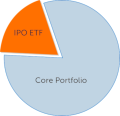Sensing vulnerability among companies needing to raise cash in the public market, IPO market vigilantes began pushing back on new issue valuations in late 2009, with the pressure increasing sharply in 2010.
An unusually-high 69% of year-to-date IPO offerings have priced below the expected range, well above the 28% average for the 2001-2009 period, as stingy investors and renewed economic uncertainties have backed issuers into a corner. The average deal is getting done at a sizeable -16% haircut to the proposed midpoint (the post-tech-bubble average is -3%) but these discounted valuations have not yet translated into higher near-term returns.
Disappointed Buyers
A common heuristic says that an IPO investor asks for a 10%-15% valuation discount to compensate for the incremental risk of an unseasoned equity. Using first-day pop as a proxy for this discount, it appears that the guideline generally held between 2005 and 2008, with the average IPO returning nearly 12% in its first trading session. Those willing to enter the IPO waters in the first half of 2009, close to the market’s nadir, were rewarded with an even-more handsome 18% average first-day pop. Always reluctant to leave too much money on the table, it appears underwriters and issuers responded by raising their asking prices, with first-day returns falling to just over 4% in the second half of the year. Given this erosion in perceived discount levels, IPO vigilantes took matters into their own hands, scrutinizing multiples and pressuring underwriters to price deals below the range.
Motivated IPO Sellers
Over the last six to nine months, the market has experienced a shift to more mature and leveraged issuers, including several private equity portfolio companies bought out at mid-decade valuations. The deleveraging hangover from the private equity bubble continues to provide a steady flow of motivated sellers, and the private equity channel accounted for four of 13 deals so far in 2010. From 2005 to present, half of private equity-backed IPOs have priced below their proposed price range, likely driven by the IPO market’s growth bias and its aversion to deals with insider selling or leverage. Looming debt maturities and liquidity concerns create motivation for private equity fund managers to sell, and buy side firms have taken the opportunity to extract better valuations.
Market Adjustments
Fortunately, issuers appear to adjust their valuations rapidly following periods of strong pricing headwinds. Directionally, we can see sharp adjustments in both pricing pressure and first-day pop in 2003 and 2009, following quarters in which more than 70% of deals priced below the range. Looking further back, we see similar reversals in 1992 and 1994 after periods of single-digit first-day returns and above-average pricing pressure. These periods of harsh pricing discipline were followed by longer periods when the majority of IPOs were priced within their ranges and, more importantly for investors, delivered more normalized first day returns.
Fundamentals Still Matter
Though recent IPO returns have been disappointing in the aggregate, investors should be keeping a close eye on new issues. Clearly, historical data suggest that underwriters are pragmatic in their response to pricing pressure and first-day duds by leaving more money on the table in subsequent offerings. Perhaps more to the point, investors can still find attractive absolute returns in the face of a strong technical headwind. Since June of 2009, down-priced IPOs that have received strong fundamental ratings in Renaissance Capital’s Pre-IPO Research have returned an average of 5% on the first-day and 7% over the first month. This compares favorably with those receiving neutral or weak fundamental IPO ratings, which have declined by -3% and -4%, respectively. Though the overall performance of the IPO market has been lackluster, it still rewards the best fundamental stories, enabling informed investors to reap attractive gains.
Conclusion
While the current period of poor IPO performance may leave buyers feeling burned, history demonstrates that such imbalances are short-lived. After all, it is in the interest of the underwriters that investors and issuers begin to see eye to eye. Thus, issuers may be forced to leave money on the table to lure buyers back to the market. In the meantime, issuer fundamentals still matter, and research that distinguishes high-quality issues can allow investors to find value in an otherwise uncertain market.
Click here to read the full report


